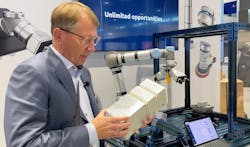The realities of modern manufacturing continue to highlight the need for automation at all levels of the production process. From ongoing labor issues created by large numbers of retiring workers to news of China’s increased investments in robotics, it’s not so much a question of whether to automate to stay competitive, but what to automate first with the use of robots.
As easy as robot deployments have become over the past few years, there is still quite a bit of work required to get them up and running. It’s at this stage of robot installation and integration that many manufacturers—especially small and medium-sized businesses—require help and could encounter costs that affect the time to achieve a return on their automation investment. It can also be a period marked by integration problems that delay implementation and/or increase budgeted expenses.
Such issues are not only a concern for end users, but system integrators as well—as integration issues negatively impact system integrator resources and project planning capabilities.
During IMTS 2022, OnRobot revealed its forthcoming product—D:Ploy—which is designed to automate the robot installation and work cell integration process. According to OnRobot, D:Ploy automatically discovers and configures the components in a robotic cell, regardless of supplier, while also integrating external I/O from other work station sensors and machines.
According to OnRobot, the D:Ploy system connects directly to the robot controller and handles all communication above the safety level. With this connectivity established, D:Ploy can automatically generate all the program logic, signal exchange, event handling, path planning, and real-time monitoring needed for the robot application.
Demonstrating D:Ploy, Enrico Krog Iversen, CEO of OnRobot, says that once you connect a robot to the D:Ploy module, users only have to scan the QR code on the module to securely connect to OnRobot’s cloud system, which can then detect all robotic components in the work cell—the robot as well as its end of arm tooling. Other components in the work cell are added to the D:Ploy software environment through an intuitive interface to further define the work space.
In the CNC machine loading app used to demonstrate D:Ploy at IMTS, users define the pick and end placement positions, as well as size and weight of the component or part in the D:Ploy software interface. Such robot programming processes typically take about 20 minutes to fully complete, said Iversen, but D:Ploy’s cloud server can calculate optimal motion of the robot in less than 20 seconds.
Kristian Hulgard, general manager of OnRobot’s Americas division, said D:Ploy’s 80% reduction in robot deployment time allows system integrators to take on more projects with existing resources, helps robot manufacturers benefit from greater accessibility to their products, and provides end users with “powerful new abilities to implement, manage, and redeploy automation across their facilities for long-term success.”
Iversen said the first release of D:Ploy will target palletizing, CNC machine tending, packaging, and material handling applications. It is expected to be available in late Q4 2022. Future releases will address de-palletizing and vision-based robot applications.
Leaders relevant to this article:


